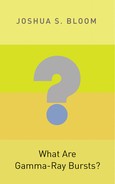PREFACE
In a strictly observational sense the question “What are gamma-ray bursts?” has a straightforward answer: gamma-ray bursts (GRBs) are unannounced flashes of high-energy light detected from seemingly random places on the sky. In the first few seconds of activity, GRBs emit as much energy as our Sun will release in its entire ten billion-year lifetime. We now believe that they are the brightest electromagnetic events in the Universe. The arrival at this mind-boggling conclusion is the result of a remarkable journey spanning the last three decades of the twentieth century. This historical tale—of an unexpected beginning, mystery, cutting-edge technology, and persistent scientists—is the main subject of chapter 1 and frames the content of the entire book.
“What are gamma-ray bursts?”—as in “what are the astrophysical origins of gamma-ray bursts?” and “what are the uses of gamma-ray bursts in helping us to understand the universe?”—is a deeper question with less certain answers. As discussed in chapter 2, the event themselves are very likely due to various interactions of particles and light with magnetic fields. These basic ingredients are carried along by an explosion of material moving at speeds close to the speed of light (chapters 3 and 4). The object or objects responsible for this fantastic explosion are, as we shall see in chapter 5, of great interest to astronomers. There is strong evidence that some GRBs are produced when stars much more massive than the Sun run out of nuclear fuel and explode. Some GRBs are likely due to gigantic magnetic flares near the surface of exotic dead stars called neutron stars. The quest to understand the diversity of the astrophysical entities that make GRBs is an ongoing one and represents one of the most pressing inquiries in modern astrophysics.
By virtue of their special properties, GRBs are emerging as unique tools in the study of broad areas of astronomy and physics (chapter 6). Indeed, while GRB astronomers continue to broaden the understanding of their nature and origin, others are using GRBs to shed light (literally) on some of the most basic questions of our time: How and when do stars form? How do the most massive stars end their lives? What makes black holes? What is the age of the Universe and what is its ultimate fate? Is very fabric of space and time different from what Einstein imagined? In this sense, gamma-ray bursts are not just one of nature’s most fantastic firecrackers but unique and powerful tools in the study of the Universe itself.
At the core, this book is meant as a thorough introduction to the relevant technical and physical concepts of the field. There are more than ten thousand papers published on the subject of GRBs,1 and so a distillation of the main concepts and observations is a particularly important. This is a book intended for astronomy enthusiasts and those with some level of training in undergraduate physical sciences. However, I presuppose no particular or specialized knowledge of astronomy and physics here. Important technical topics, concepts, and useful jargon (highlighted first in italics) are either defined in the text or in the glossary toward the back of the book. Less important phrases or concepts are given in quotes. References to seminal discovery papers and other primary sources are provided in the notes. Equations are used (but sparingly). I present graphs and figures, most adapted directly from academic research papers; the adage that a “picture is worth a thousand words” holds for astrophysicists too!
This book is also intended as a point of departure for those interested in pursuing the subject matter in more depth: suggested readings (both popular and academic in nature) are highlighted at the back of the book. Someone with a strong physics and astronomy training, looking for more depth than what is provided here, will find a relatively recent comprehensive review of both theory and phenomenology in Gamma-Ray Bursts: The Brightest Explosions in the Universe, by Gilbert Vedrenne and Jean-Luc Atteia (2009).
I am indebted to all those who have endeavored to push to the technical and scientific forefront of the field. I thank my research advisors: Edward E. Fenimore, Jonathan (Josh) E. Grindlay, Martin J. Rees, Ralph A.M.J. Wijers, Dale A. Frail, and Shrinivas R. Kulkarni. As scientists they each contributed in remarkable and unique ways to the development of the GRB field; as mentors they had their own profound impact on my professional development. I am particularly grateful for the years of interactions with my GRB-oriented graduate students (Andrew Friedman, Adam Morgan, and Daniel Perley) and postdoctoral scholars (Nathaniel Butler, S. Bradley Cenko, Bethany Cobb, Daniel Kocevski, Maryam Modjaz, and David Pooley). I am extraordinarily thankful for years of collaborations with many of the people whose work is presented here, especially J. Xavier Prochaska and Hsiao-Wen Chen. This book benefitted enormously from the feedback of anonymous reviewers on a draft of the manuscript as well as close reads from Mark Galassi, Adam Morgan, Bethany Cobb, Maryam Modjaz, S. Bradley Cenko, and Daniel Perley. All errors and omissions that remain in the published book are entirely my own. Enjoy!
Joshua S. Bloom
Berkeley, California
July 2010
